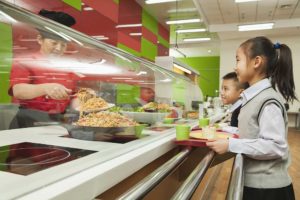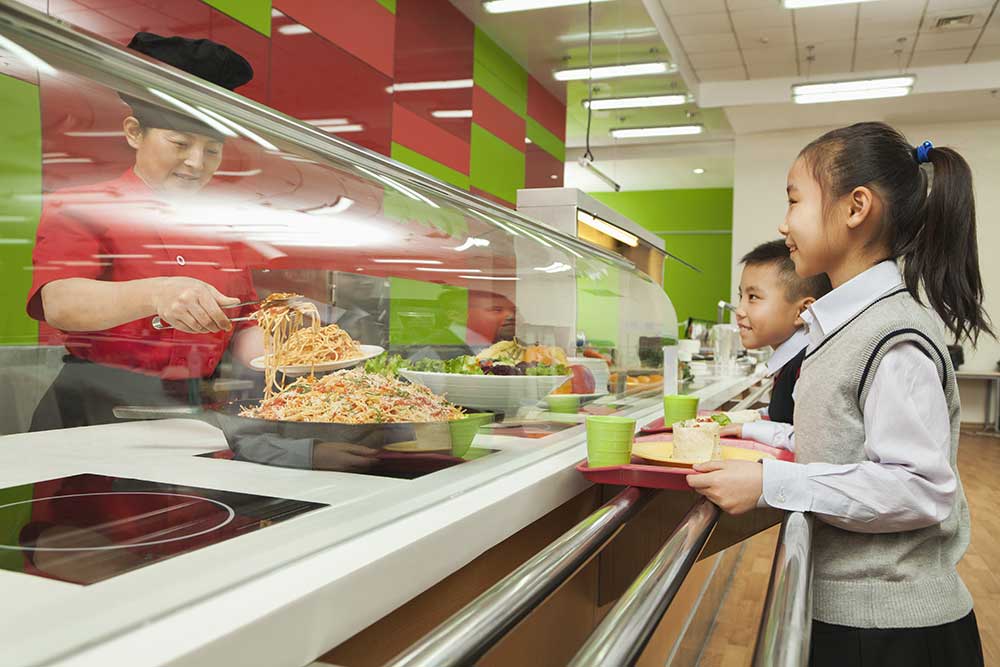Disclaimer: The information on our website is provided for general information purposes only. We make no representations or warranties of any kind, express or implied, about the completeness, accuracy, reliability, suitability or availability with respect to the website or the information contained on our website for any purpose. Any reliance on such information is therefore strictly at your own risk and we are not liable for any damages or losses arising out of or resulting from your reliance on any information contained on our website.
A cafeteria cook prepares large quantities of food in a cafeteria setting. This may include working at schools, hospitals, and could include food providers with buffet style serving. They may work with kitchen appliances that can handle large portions of food. They should also be very familiar with food storage and sanitation best practices.
Watch a video to learn what a cafeteria cook does:
How to Become a Cafeteria Cook
There is no minimum educational requirement to become a cafeteria cook. According to O*NET OnLine, about half of all cafeteria cooks have not attained a high school diploma and the other half has earned a high school diploma. Some cooks may start out with no experience and be trained on-the-job. Others may have prior restaurant or food service experience and become employed as a cafeteria cook.
Job Description of a Cafeteria Cook

Cafeteria workers must prepare ingredients and follow recipes to cook large portions of food for a large number of people. They must then cook the food and ensure to check the food often to ensure a quality end result. These workers may also help serve their customers after the food has been prepared. In addition to cooking and serving, they may also be responsible to clean up the cafeteria’s serving area and kitchen area after the customers have left. Ensuring the food serving area and equipment are clean is also a top priority as they must ensure they follow sanitation and food storage best practices.
These workers work as part of a team and maybe on their feet for a long period of time. Depending on the type of location they work at, these workers may start their shift very early in the day to be ready for their breakfast or lunch customers. They may also work a variety of locations from schools, hospitals, large corporations that may have a cafeteria for their employees, or restaurants that have more of a buffet-style food service.
Benefits of Being a Cafeteria Cook
We are happy you have taken advantage of this article to discover what a cafeteria cook is and how to become one! That is essential information, but we would like to share more, like the benefits of the job!
- Many cafeteria cooks agree that having time off is an excellent job benefit! Only a few other careers offer that! In addition, no overtime, evenings, or weekend hours are required!
- How many jobs offer free lunch? Cafeteria cooks get one!
- Most cafeteria cooks like to interface with others, like co-workers and customers, and this job has plenty! They also like talking with children if they work in a school setting!
- Cafeteria cooks can begin working with no formal education. We want to tell you that by furthering your education, you can move into other jobs, like teaching or chef! They are always learning new skills, so moving into different positions greatly benefits them.
- There are standard benefits to the job for a cafeteria cook, like health insurance, paid sick and vacation days, and retirement plans. Some companies may offer tuition assistance.
- Cafeteria cooks benefit from working indoors in clean environments, which means they can work rain or shine!
Cook Job Posting
Let’s look at a job description posted by the Department of the Army. This job announcement is looking for a person to perform the following responsibilities:
- Assignments are received orally or in writing from the supervisor in the form of cooks worksheet, menus, standardized recipes and meal schedules.
- Supervisor or higher-grade cook provides detailed instructions on cooking methoda and use of equipment for new or more difficult assignments.
- Employee is responsible for the proper use and cleaning of kitchen equipment, safety practices, personal hygiene and conformance with food service sanitation requirements.
- Higher grade cook is available to answer technical questions and to ensure that the work is being done properly.
- Completed work is evaluated in terms of quality of food cooked, and adherence to time schedules and instructions.
- Performs a full range of simple cooking. Makes cold sandwich fillings. Sets up and replenishes salad bar.
- Prepares food by peeling, chopping, grinding, paring, cutting, slicing, dicing, pureeing, dredging, flouring, or breading. Operates a variety of kitchen equipment using gas, electricity, steam or microwave heat sources.
This position was posted to run 01/07/2019 until 04/30/2019 with a salary range of $12.81 to $13.32 per hour on USAjobs.gov (link opens in a new tab). USAjobs.gov is an official website of the United States government and part of the U.S. Office of Personnel Management.
Free Teacher and Student Resources
Harvard University offers a free Science and Cooking course on EdX.org (link opens in a new tab) with the option to pay a small fee receive a verified certificate upon completion of the course.
By taking this course, you’ll learn:
- The chemical and physical principles that underlie everyday cooking and haute cuisine techniques.
- How chefs can use enzymes to make foods that would otherwise be impossible.
- How to use the scientific method to learn how a recipe works, and find ways you could improve it.
- How to think like a chef AND a scientist.
Cafeteria Cook Career Video Transcript
For most of us, our first experience with a cafeteria is eating lunch at school. But many other institutions such as hospitals and businesses provide similar in-house food services. The people who prepare the meals are called institution and cafeteria cooks. Often referred to as food service chefs or executive chefs, they have a big job to do.
A large variety of foods need to be provided for hundreds, even thousands, of customers every day. For each meal, cooks prepare menus that often include soups, salads, entrees, side dishes, and desserts. They work in huge kitchens, usually assisted by a staff of helpers. In addition to giving orders, this job requires following written directions, such as recipes. Being able to multi-task is important, since many items need to be prepared at the same time.
Most of the shift is spent standing in front of hot stoves and ovens or at the cutting board. Because you’re working with very large quantities, cookware is far heavier than what people use at home. Skills can be learned in vocational school or on-the-job. And although a high school diploma is not required its recommended. Especially for those planning a career as a cook. Hours vary and may include early mornings, late nights, holidays, and weekends. This could be a good job for those seeking supplemental income, flexible hours, or variable schedules. Whether serving hungry students or employees grabbing a quick bite, large-scale food services depend on the special talents of institution and cafeteria cooks.
Article Citations
Bureau of Labor Statistics, U.S. Department of Labor, Occupational Outlook Handbook, Cooks, Institution and Cafeteria.
National Center for O*NET Development. 35-2012.00. O*NET OnLine.
The career video is in the public domain from the U. S. Department of Labor, Employment and Training Administration.

